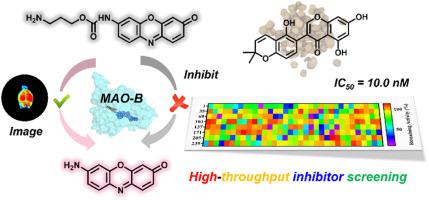mao - b活化荧光探针活性评价的合理设计及其生物医学应用
IF 8.2
2区 生物学
Q1 BIOCHEMISTRY & MOLECULAR BIOLOGY
引用次数: 0
摘要
单胺氧化酶主要包括单胺氧化酶A (MAO-A)和单胺氧化酶B (MAO-B)两种异构体,其中单胺氧化酶B是一种重要的代谢酶,作用于多巴胺和β-苯乙胺,可被pargyline选择性抑制。MAO-B已成为多种神经系统疾病的重要药物靶点。本文设计并研制了一种高选择性、高灵敏度的3-氨基丙基(3-氧- 3h -苯恶嗪-7-基)氨基甲酸酯(AHPC)荧光探针。AHPC在生物系统中表现出良好的稳定性和细胞膜通透性,能够实时检测内源性MAO-B活性,准确评价过氧化氢诱导氧化应激下MAO-B的变化。此外,AHPC还能检测到MAO-B在不同器官中的分布。由于MAO-B是一个重要的药物靶点,我们基于AHPC开发了一种高通量的MAO-B抑制剂视觉筛选系统。从272种中药中筛选出甘草,对MAO-B具有较强的抑制作用。进一步对甘草根茎进行分离,发现Licoisoflavone B是抑制不同酶源MAO-B活性的主要活性成分,有望成为治疗MAO-B相关疾病的先导化合物。综上所述,利用荧光探针技术的优势,我们不仅开发了一种方便的分子工具来实时检测复杂生物系统中MAO-B的分布和功能,而且还建立了一种高通量的可视化方法来筛选中药中MAO-B抑制剂,这些抑制剂有望用于治疗许多MAO-B相关疾病。本文章由计算机程序翻译,如有差异,请以英文原文为准。

Rational design of MAO-B-activated fluorescent probe for activity evaluation and its biomedical applications
Monoamine oxidase mainly includes two isoforms, monoamine oxidase A (MAO-A) and monoamine oxidase B (MAO-B), of which MAO-B is a crucial metabolic enzyme, acts on dopamine and β-phenylethylamine and can be selectively inhibited by pargyline. MAO-B has emerged as a significant drug target for a variety of nervous system diseases. In the present work, a highly selective and sensitive fluorescent probe named 3-aminopropyl (3-oxo-3H-phenoxazin-7-yl) carbamate (AHPC) was designed and developed. AHPC showed good stability and cell membrane permeability in biological systems, and could detect endogenous MAO-B activity in real time, and accurately evaluate the changes of MAO-B under H2O2-induced oxidative stress. In addition, AHPC was able to detect the distribution of MAO-B in different organs. As MAO-B is an important drug target, we developed a high-throughput, visual screening system for MAO-B inhibitors based on AHPC. Glycyrrhizae radix et rhizome was screened from 272 kinds of Chinese medicine and displayed strong inhibitory effect toward MAO-B. After further separation of Glycyrrhizae radix et rhizome, it was found that Licoisoflavone B was the main active ingredient to inhibit MAO-B activity in different enzyme sources, and was expected to be a lead compound for the treatment of MAO-B-related diseases. In conclusion, with the advantages of fluorescent probe technology, we not only developed a handy molecular tool for real-time detection of MAO-B distribution and function in complex biosystems, but also established a high-throughput visualization method for screening MAO-B inhibitors from traditional Chinese medicine, which are promising for the treatment of many MAO-B-related diseases.
求助全文
通过发布文献求助,成功后即可免费获取论文全文。
去求助
来源期刊

Free Radical Biology and Medicine
医学-内分泌学与代谢
CiteScore
14.00
自引率
4.10%
发文量
850
审稿时长
22 days
期刊介绍:
Free Radical Biology and Medicine is a leading journal in the field of redox biology, which is the study of the role of reactive oxygen species (ROS) and other oxidizing agents in biological systems. The journal serves as a premier forum for publishing innovative and groundbreaking research that explores the redox biology of health and disease, covering a wide range of topics and disciplines. Free Radical Biology and Medicine also commissions Special Issues that highlight recent advances in both basic and clinical research, with a particular emphasis on the mechanisms underlying altered metabolism and redox signaling. These Special Issues aim to provide a focused platform for the latest research in the field, fostering collaboration and knowledge exchange among researchers and clinicians.
 求助内容:
求助内容: 应助结果提醒方式:
应助结果提醒方式:


